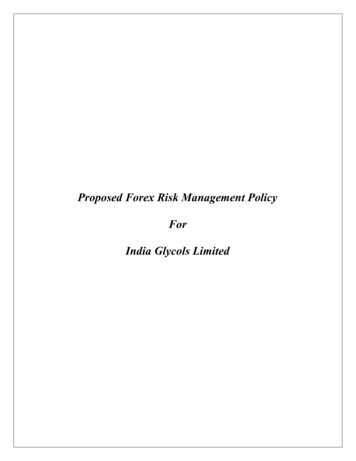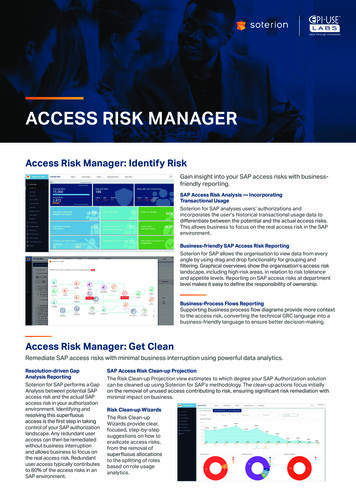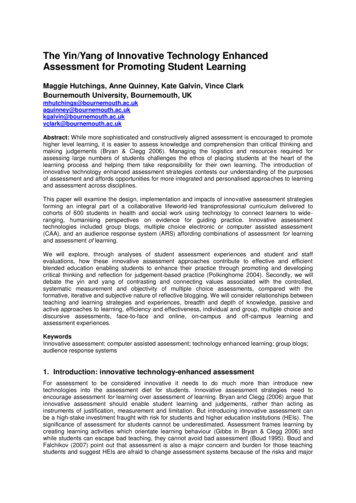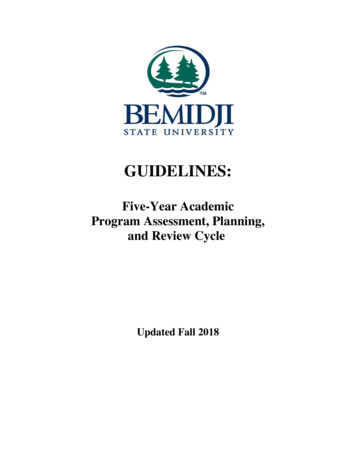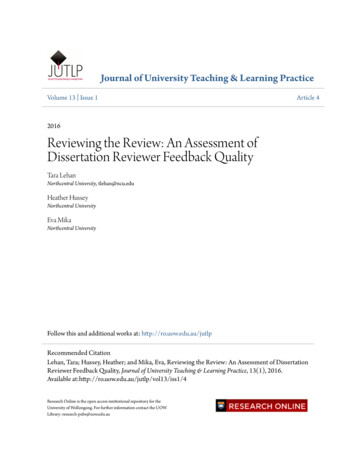
Transcription
Journal of University Teaching & Learning PracticeVolume 13 Issue 1Article 42016Reviewing the Review: An Assessment ofDissertation Reviewer Feedback QualityTara LehanNorthcentral University, tlehan@ncu.eduHeather HusseyNorthcentral UniversityEva MikaNorthcentral UniversityFollow this and additional works at: http://ro.uow.edu.au/jutlpRecommended CitationLehan, Tara; Hussey, Heather; and Mika, Eva, Reviewing the Review: An Assessment of DissertationReviewer Feedback Quality, Journal of University Teaching & Learning Practice, 13(1), 2016.Available at:http://ro.uow.edu.au/jutlp/vol13/iss1/4Research Online is the open access institutional repository for theUniversity of Wollongong. For further information contact the UOWLibrary: research-pubs@uow.edu.au
Reviewing the Review: An Assessment of Dissertation Reviewer FeedbackQualityAbstractThroughout the dissertation process, the chair and committee members provide feedback regarding quality tohelp the doctoral candidate to produce the highest-quality document and become an independent scholar.Nevertheless, results of previous research suggest that overall dissertation quality generally is poor. Becausemuch of the feedback about dissertation quality provided to candidates, especially those in online learningenvironments, is written, there is an opportunity to assess the quality of that feedback. In this study, acomparative descriptive design was employed using a random sample of 120 dissertation reviews at oneonline university. Common foundational errors across dissertations and strengths and growth areas inreviewer feedback were noted. Whereas reviewer feedback quality was acceptable overall, there weresignificant differences across reviewers. Based on the findings, increased discourse, standardization ofpsychometrically sound measures that assess reviewer feedback quality, and ongoing training for facultymembers who review dissertations might be warranted.Keywordsdissertation; reviewer; feedback; quality; assessment; distanceThis journal article is available in Journal of University Teaching & Learning Practice: http://ro.uow.edu.au/jutlp/vol13/iss1/4
Lehan et al.: Reviewing the ReviewIntroductionAs an integral part of the peer-review process used by many academic journals, reviewers arecharged with identifying foundational flaws and providing useful feedback with the goal ofimproving quality (Caligiuri & Thomas 2013). Acting as gatekeepers, they play a key role indetermining what work is deemed to contribute to the scholarly literature (Caligiuri & Thomas2013; Min 2014). This process helps authors refine and advance the document and aids inmaintaining standards of scientific quality (Onitilo, Engel, Salzman-Scott & Doi 2014).However, not all reviews are perceived as being equally helpful (Suls & Martin 2009). Thereappears to be consensus among scholars regarding not only the importance of the peer-reviewprocess but the need to improve it (Caligiuri & Thomas 2013; Min 2014; Onitilo et al. 2014;Schoroter, Tite, Hutchings & Black 2006; Suls & Martin 2009; Szekely, Kruger & Krause2014). According to Caligiuri and Thomas (2013), reviewer comments that are deemed to be themost helpful include those in which reviewers include suggestions for improvement, advice tosolve problems, alternate ways to analyze data and feedback regarding the manuscript’scontribution to the field. Unfortunately, such comments are uncommon.In general, there often is inconsistency across reviews in terms of helpfulness, thoroughness anduse of evidence versus opinions (Caligiuri & Thomas 2013; Min 2014; Onitilo et al. 2014;Schoroter et al. 2006). Kumar, Johnson and Hardemon (2013) reported that the feedback offeredby reviewers frequently is difficult to understand. Szekely and colleagues (2014) suggested thatmany reviews are biased, inconsistent and sometimes outright wrong.Because few reviewers are trained to review, or even receive feedback about their reviews, theyoften do not realise that they are biased (Caligiuri & Thomas 2013; Min 2014). Consequently,there is a need to examine reviewer feedback (Szekely et al. 2014). Just as scholars benefit fromfeedback on their work, so should reviewers. Snell and Spencer (2005) found that reviewers wouldappreciate such feedback. Helpful reviewers go beyond identifying problems with the manuscriptand offer specific suggestions regarding how to improve the methodology or analyse the data inanother way (Caligiuri & Thomas 2013; East, Bitchener & Basturkmen 2012). This process alsohelps to enhance reviewer accountability and ensure that reviews are constructive and informativeon how to move forward.Whereas much of the research on review quality has involved journal reviewers, feedback fromdissertation chairs and committee members about dissertations also warrants scholarly attention.Such feedback is an integral part of doctoral education, as it helps to train doctoral candidates tolearn about the writing process, improve their critical-thinking skills and understand theexpectations of the academic community (Basturkmen, East & Bitchener 2014; Kumar & Stracke2007). Many dissertation-committee members state that they can recognise a quality dissertationwhen they see it, adding that they can describe general characteristics of outstanding, very good,acceptable and unacceptable dissertations (Lovitts 2005). This perspective is consistent with theapprentice model, which is based on the assumption that dissertation advisors can mentorcandidates without additional training (Barnes & Austin 2008). Similarly, many faculty membersreport making holistic decisions about a dissertation versus using some type of rubric orstandardised checklist (Lovitts 2005). However, much as with manuscripts submitted to academicjournals, a standardised process for document review might improve quality (Lovitts 2005; Onitiloet al. 2014; Ronau 2014).1
Journal of University Teaching & Learning Practice, Vol. 13 [2016], Iss. 1, Art. 4There is a lack of research on the quality of the feedback given to candidates (Basturkmen et al.2014; Bitchener & Basturkmen 2010; East et al. 2012), especially online doctoral students, forwhom written feedback is especially crucial (Kumar et al. 2013). Inconsistencies in dissertationquality have been noted (Basturkmen et al. 2014; Nelson, Range & Ross 2012). Boote and Beile(2005) found variable quality across dissertations, with overall quality being low. Similarly, manyfaculty members note that it is uncommon to find an exceptional dissertation (Boote & Beile 2005;Lovitts 2005). Given that dissertation quality commonly is poor and that quality acrossdissertations is inconsistent, the quality of dissertation-reviewer feedback warrants attention. Toaddress this critical gap in the literature, the current study aimed to examine the quality ofreviewer feedback on dissertations at various stages.MethodContext of studyAlthough the focus of this study is on the continuous-improvement process as opposed to thespecific review process, it is helpful to understand the latter to understand the former. The reviewprocess employed in this study was implemented at a completely online university that primarilygrants doctoral degrees. The model included a full-time dissertation chair, subject-matter expert(SME) and reviewer who engaged in a single-blind review process. The reviewer served a similarrole to that of a journal reviewer, with limited ongoing interaction with either committee membersor students beyond milestone reviews. However, dissertation chairs could correspond withreviewers if there were questions about reviewer feedback. Both dissertation chairs and reviewershad demonstrated expertise in both quantitative and qualitative research methods. In addition, theyreceived ongoing training based on findings of continuous-improvement initiatives.Candidates completed their dissertation in three phases: concept paper (CP), dissertation proposal(DP) and dissertation manuscript (DM). At each stage, once the chair, SME and candidatebelieved that the document was of sufficient quality to pass onto the next phase, the chairsubmitted it for review by an academic reviewer. Upon receiving the document, the reviewercould either choose to give it a full review or defer it because the document was of such poorquality that it was not ready for a full review. Reviewers were expected to use the defer dispositionwhen a CP or a DP either had a foundational error that affected all other components of thedocument, such as a poorly articulated or unsubstantiated problem statement, or containednumerous foundational errors that seriously affected the quality of the work or violated some ruleof research. Reviewers did not have the option to use the defer disposition at the DM stage or afterone full review had already occurred at the CP or DP stage.For CPs and DPs that did not have a foundational error, reviewers had the option of using either aresubmit or a final-feedback disposition. They were told that final feedback was only to be givenin a first full review when no foundational errors existed, although final feedback had to be givenat the second full review. Regardless of the disposition, reviewers were expected to go through thedocument, highlight any issues and offer suggestions, reflective questions and resources on howthe noted issues might be addressed. Each document was only given two full reviews (notincluding deferrals).Under the model employed by this university, reviewers had a limited amount of time(approximately two hours) to devote to each review. The prescribed time limit was based on theintended focus to fine-tune the document. The assumption was that the documents submitted forhttp://ro.uow.edu.au/jutlp/vol13/iss1/42
Lehan et al.: Reviewing the Reviewreview were free of foundational errors, so two hours should have been sufficient to providesubstantive feedback in most cases.PopulationThe population comprised all 818 dissertation reviews completed in 2014 between January 1 andMay 5 to include those with a defer, resubmit or final-feedback disposition. This includedtheoretical (PhD) and applied doctoral dissertations from the four schools within the university(Education, Marriage and Family Sciences, Psychology and Business). These dissertations wereall reviewed by one of six reviewers whose sole responsibility at the university was to providefeedback on the quality of dissertations and provide a disposition.SampleOf these 818 reviews, 20 were selected for each of the six reviewers (n 120). Each reviewerhad approximately the same number of CPs, DPs and DMs. In the sample, there were 56 CPreviews, 33 DP reviews and 31 DM reviews. This distribution was consistent with that of thelarger population, which included 445 reviews of CPs, 227 reviews of DPs and 146 reviews ofDMs completed from January 1 through May 5, 2014. In terms of disposition, 26 milestonedocuments were deferred, 44 required resubmission and 50 contained final feedback. Thisdistribution was consistent with that of the larger population, which included 155 defer, 263resubmit and 319 final feedback dispositions given from January 1 through May 5, 2014.InstrumentThe instrument used in this study was developed in alignment with the three dissertation milestonedocuments (CP, DP and DM) submitted by the chair for academic review. The items on theinstrument aligned with the dissertation templates and guidebooks provided to doctoral candidatesand their chairs, and encompassed all foundational components (feasibility of problem statement;alignment of problem, purpose, and methods; quality of data collection and analysis; andevaluation and implication of findings). The items also reflected the deferral criteria that reviewersused to assess a dissertation milestone document’s foundational components. The three-pointLikert-type scale in the instrument consisted of Needs Improvement (reviewer did not detectshortcomings), Acceptable (reviewer detected shortcoming and provided general advice), andExceptional (reviewer identified shortcoming and provided specific feedback, recommendations,and resources), which reflected both the basic quality-assurance function of the review process andthe added function of educating the doctoral candidate. If no foundational error was present, theraters were instructed to select Not Applicable. In addition, they were asked to give an overallrating of Sufficient/Acceptable or Insufficient/Unacceptable. Prior to its use in this study, thisinstrument was piloted, and revisions were made based on the results.ProcedureGiven the purpose of this study, a comparative descriptive design was employed. Several stepswere taken to enhance validity and reliability. Only one review per doctoral candidate wasincluded in the sample to ensure that observations were independent. To begin, every possiblecombination of school (Business, Marriage and Family Sciences, Education, Psychology), degreetype (applied, PhD), stage (CP1, CP2, DP1, DP2, DM1, DM2) and disposition (deferred, resubmit,final) was generated using Excel. All identifying information, including the names and contactinformation of the candidate, chair and SME, was removed from the milestone documents. For the3
Journal of University Teaching & Learning Practice, Vol. 13 [2016], Iss. 1, Art. 4first two rounds of selection, the dissertation coordinator randomly selected one review torepresent each possible combination when at least one existed; however, there was not always areview in the population for each combination. In particular, there were very few reviews in 2014for documents written by candidates in the School of Marriage and Family Sciences. For the firsttwo rounds, after stratifying the sample by school/degree type/stage/disposition, the dissertationcoordinator generated random numbers for each review and selected every tenth one to be rated.For the subsequent rounds, after it was ensured that all possible combinations were represented byat least one review, the focus shifted to having an even number of reviews per reviewer.Therefore, the dissertation coordinator stratified the sample by reviewer and randomly selectedreviews in a similar manner to the first two rounds.Three research directors within the Graduate School served as blind raters of the reviewers’feedback. They did not know who the candidate, chair or SME were while completing theirratings. Further, raters received two trainings on how to use the instrument consistently, onebefore and one after the first round of ratings.ResultsInter-rater reliabilityThree independent raters used the developed scale to assess the quality of reviewer feedback. Todetermine the level of agreement between raters, reviewer feedback in 25 documents was rated bya fourth independent rater. Of those 25 sets of ratings, 16 had ratings that were reliable in terms ofboth item ratings (user missing N/A, Needs Improvement 1, Acceptable 2, Exceptional 3) andoverall ratings (Sufficient/Acceptable 1, Insufficient/Unacceptable 0). For the documents to beincluded in the sample, the overall ratings had to be the same. In addition, at least 50% of the itemratings had to be exactly the same. Given that the scale used was ordinal, but included a nominalrating (N/A), commonly used reliability coefficients would be misleading. Although calculatingpercentage of exact agreement is an underestimate of inter-rater reliability, this strategy was used.Percentage agreement on all item ratings per review ranged from 50% to 100%, with the averagebeing 66.94%.Descriptive statisticsMost common foundational errors. Several foundational errors were present in most of thedocuments examined, which means that the candidate, SME and chair all failed to recognise andaddress them prior to submitting the documents for review. In some cases, the reviewer also didnot highlight one or more foundational errors. The following section includes a description of themost common foundational errors in the reviewed documents, including both those generallyhighlighted and those generally not highlighted by reviewers.The most common foundational errors in CPs and DPs were also the ones that were frequentlyhighlighted by reviewers. They included a lack of alignment of core components (present in54out of 56 CPs and 29 out of 33 DPs) and lack of articulation and substantiation of the problemstatement (present in 49 out of 56 CPs and 28 out of 33 DPs). The most common foundationalerrors in the DMs were frequently highlighted by reviewers. They included insufficientexplication of a rationale for the design, including use of seminal authors (present in 21 out of31 DMs); improper presentation and organisation of results (present in 20 out of 31 DMs); andissues with recommendations (present in 20 out of 31 DMs).http://ro.uow.edu.au/jutlp/vol13/iss1/44
Lehan et al.: Reviewing the ReviewTable 1. Foundational errors generally highlighted in reviewer feedbackFoundationalErrorNo. ofDocumentswith ErrorNo. ofDocumentswithAcceptableCommentNo. ofDocumentswithExceptionalCommentNo. ofDocumentswith NoComment% ofDocumentswith ErrorCorrectlyHighlighted4925101471.4Lack offeasibility &relevance oftopic22141768.2Lack ofalignment operationalisedvariables/constructs1892761.1Lack ofalignment ofcorecomponents291431258.62012448020130765Of 56 CPsLack ofarticulation &substantiationof problemstatementOf the 33 DPsLack ofarticulation &substantiationof PSOf the 31 DMsImproperpresentation &organisation ofresultsIssues withrecommendationsaAn acceptable comment is one in which the specific foundational error was highlighted with general advice about how to move forward.An exceptional comment is one in which the specific foundational error was highlighted with specific advice about how to move forwardand recommendations/resources.b5
Journal of University Teaching & Learning Practice, Vol. 13 [2016], Iss. 1, Art. 4Foundational errors frequently highlighted by reviewers. To determine which foundationalerrors reviewers frequently highlighted in general, measures of central tendency for each itemwere examined. Those with a median of 2.0 (sample median) or greater and a mode of 2 orgreater were included in the lists, as 2 corresponded with an Acceptable rating. Table 1 showsthe foundational errors that were generally highlighted in reviewer feedback, the number ofdocuments that contained that error, the number of documents in which the reviewer highlightedthe error with general as well as specific advice, the number of documents in which the reviewerdid not highlight the error and the percentage of documents containing that error in which thereviewer at least highlighted it and provided general advice about how to move forward. As thetable shows, reviewers generally highlighted the two same foundational errors (lack ofalignment of core components and lack of articulation and substantiation of the problemstatement) at the CP and the DP stage. The only commonly highlighted foundational error forwhich no reviewer provided specific advice and recommendations/resources related to issueswith the recommendations in the DM.Foundational errors frequently not highlighted by reviewers. To determine which foundationalerrors reviewers frequently did not highlight, the measures of central tendency for each item wereexamined. Those with a median lower than 2.0 (sample median) and mode lower than 2 wereincluded in the lists, as 2 corresponded with an Acceptable rating. Table 2 shows the foundationalerrors that were generally not highlighted in reviewer feedback, the number of documents thatcontained that error, the number of documents in which the reviewer highlighted the error withgeneral as well as specific advice, the number of documents in which the reviewer did nothighlight the error and the percentage of documents containing that error in which the reviewer atleast highlighted it and provided general advice about how to move forward. None foundationalerrors that reviewers generally did not highlight at the CP stage were generally highlighted at theDP stage (lack of an explication of the rationale for the design, potential ethical issues/breachesand lack of synthesis and critical analysis in the brief literature review). In addition, two of thosefoundational errors (lack of an explanation of the rationale for the design and potential ethicalissues/breaches) were generally not highlighted at all three stages. Two of the foundational errorsthat were generally not highlighted by reviewers in DPs were also generally not highlighted inDMs (lack of alignment across chapters/core components and issues with the sampling protocol).Further, reviewers infrequently provided exceptional feedback for the foundational errors thatwere generally not highlighted. Notably, whereas a majority (21 of 31) of the DMs lacked asufficient explanation of the rationale for the selected design, in only one document did thereviewer highlight it.Overall ratings. Of the 120 reviews in the sample, 31 (25.8%) received an overall rating ofSufficient/Acceptable. That is, at a minimum, the reviewer highlighted every foundational error inthe document and provided general advice (Acceptable). In some cases, the reviewer also providedspecific advice within the context of the study as well as recommendations and resources whenappropriate (Exceptional). As previously stated, even if a reviewer did not highlight just onefoundational error, the review had to be rated Insufficient/Unacceptable overall. Further, even ifthe review was exceptional, if the disposition was not appropriate, the review had to be ratedInsufficient/Unacceptable overall. In two reviews, the item ratings all met or exceeded 2(Acceptable), but the reviews were deemed to be Insufficient/Unacceptable overall because thereviewer failed to highlight just one foundational error. In four reviews, the item ratings met orexceeded 2, but the reviews were deemed to be Insufficient/Unacceptable overall because theyshould have been deferred due to the number and severity of the foundational errors.http://ro.uow.edu.au/jutlp/vol13/iss1/46
Lehan et al.: Reviewing the ReviewTable 2. Foundational errors generally not highlighted in reviewer feedbackFoundational ErrorNo. ofDocumentswith ErrorNo. ofDocumentswithAcceptableCommentNo. ofDocumentswithExceptionalCommentNo. ofDocumentswith NoComment% ofDocumentswith ErrorCorrectlyHighlighted451662348.8Potential ethicalissues/breaches1040640Lack of synthesisand critical analysisin literature review32722328.11251650Inappropriate levelof detail providedin the methodssection20461050Issues withsampling protocol251021348Lack of explanationof rationale fordesign22641245.5Potential tical/conceptualframework1541933.3Lack of synthesisand critical analysisin literature review18411327.8251021348Of 56 CPsLack ofexplanation ofrationale for designOf the 33 DPsLack of feasibilityand relevance oftopicOf the 31 DMsInsufficientcomparison ofstudy findings toexisting literature7
Journal of University Teaching & Learning Practice, Vol. 13 [2016], Iss. 1, Art. 4Lack of alignmentacross chapters andcore components18711044.4Lack of clarity andintegration ofconclusions1780947.1Statistical analysisand/or analyticalstrategy that is notaligned withhypotheses and/orresearch questions18701138.9Insufficientdiscussion oflimitations18701138.9Presentation offindings that isunrelated to ial ethicalissues/breaches310233.3Issues withsampling protocol15301220No pilot studies/field tests forinstruments/protocols14201214.3Lack ofexplanation ofrationale for design2110204.8aAn acceptable comment is one in which the specific foundational error was highlighted with general advice about how to move forward.An exceptional comment is one in which the specific foundational error was highlighted with specific advice about how to move forwardand tlp/vol13/iss1/48
Lehan et al.: Reviewing the ReviewDifferences in the number of Sufficient/Acceptable overall ratings were noted for each milestonestage. Of the 56 CPs in the sample, 19 (33.9%) were rated as Sufficient/Acceptable overall. Of the33 DPs in the sample, 11 (33.3%) were rated as Sufficient/Acceptable overall. However, of the 31DMs in the sample, only 1 (3.2%) was rated as Sufficient/Acceptable overall.There was also a clear trend in terms of the number of Sufficient/Acceptable overall ratings acrossreviewers (Table 3), with most (77.4%) of the Sufficient/Acceptable reviews being associated withthree reviewers. Of the 31 documents that received an overall rating of Sufficient/Acceptable, onereviewer did not have any. On the other hand, one reviewer had 11 reviews that were deemed to beSufficient/Acceptable overall. This same reviewer had ratings of 3 (Exceptional) on all applicableitems on another document, but the review received an overall rating of Insufficient/Unacceptablebecause the document should have been deferred due to the number and severity of thefoundational errors. Similarly, in some cases reviewers had ratings of 3 (Exceptional) on allapplicable items, but the review received an overall rating of Insufficient/Unacceptable becausethe document should have been deferred due to the presence of one or more foundational errors.Table 3. Number of Insufficient/Unacceptable and Sufficient/Acceptable reviews by reviewerReviewer123456No. of Insufficient/Unacceptable Reviews17 (85%)16 (80%)9 (45%)13 (65%)14 (70%)20 (100%)No. of Sufficient/Acceptable Reviews3 (15%)4 (20%)11 (55%)7 (35%)6 (30%)0 (0%)To determine if there were significant differences across reviewers in terms of the number ofdocuments that received an overall rating of Sufficient/Acceptable, a chi-square test wasconducted using the contingency table above. Results showed that the number of2Sufficient/Acceptable documents across reviewers was significantly different, χ (5, n 120) 18.49, p .002. Upon review of the standardised residuals and using a critical value of 1.96 (α .05), it was found that Reviewer 3 had significantly more and Reviewer 6 had significantly fewerreviews deemed to be Sufficient/Acceptable than the other reviewers (as shown by a standardisedresidual of 2.6 and 2.3, respectively).Item ratings. Given the ordinal scale of measurement and the positive skewness of the data, themedian was the most meaningful measure of central tendency. Across all reviews examined forthis project, the median item rating was 2.0 (IQR: 1.0), which corresponded with an Acceptablerating. Because a review could have an overall rating of Insufficient/Unacceptable, despiteAcceptable and/or Exceptional item ratings, it was important to examine both item ratings andoverall ratings. In addition, the scale was treated as ordinal, as items rated as N/A were coded asuser missing data. A Kruskill-Wallis test was employed to determine if there were significantdifferences across reviewers in terms of median item ratings. Results showed that item ratings2differed significantly across reviewers, χ (5, n 120) 35.72, p .001. Given that the overall testyielded significant results, post-hoc tests were conducted using the Mann-Whitney U Test.Because multiple comparisons were made, the a priori alpha level was set at .003. Results showed9
Journal of University Teaching & Learning Practice, Vol. 13 [2016], Iss. 1, Art. 4that significant differences existed between: Reviewer 2 and both Reviewer 3 (U 80.0, p .001, r .38) and Reviewer 4 (U 94.0,p .002, r .28). Reviewer 6 and Reviewer 3 (U 39.0, p .001, r .44), Reviewer 4 (U 56.0, p .001, r .40), and Reviewer 5 (U 75.0, p .001, r .34).For the most part, these results seem to be consistent with those of the chi-square test of overallratings. Specifically, Reviewer 3 had significantly more reviews with Sufficient/Acceptableoverall ratings than the other reviewers and significantly higher item ratings than both Reviewer 2and Reviewer 6. Reviewer 6 had significantly fewer reviews with Sufficient/Acceptable overallratings than the other reviewers and had significantly lower item ratings than Reviewers 4 and 5(in addition to Reviewer 3). Further, it was found that Reviewer 2 had significantly lower itemratings than Reviewer 4 (in addition to Reviewer 3 as stated above).DiscussionAlthough the structure and roles associated with dissertation committees can vary acrossuniversities, all committee members serve as guides and advisors through offering feedback todoctoral candidates on their dissertations (Bloomberg & Volpe 2012). Nevertheless, little isknown about the quality of this feedback, especially that given to online doctoral candidates, forwhom written feedback is especially important. If quality feedback is not provided to candidates,they might not produce high-quality dissertations or develop into independent scholars. To addressthis gap in the literature, the current study involved independent raters’ inspecting eachdissertation review for any foundational errors that might have been missed and any inappropriatedispositions made by reviewers. Despite the use of a deficit approach, it was found that manyaspects of reviewer feedback were acceptable or exceptional. At the same time, several areas forimprovement became evident.Strengths of reviewer feedbackIn approximately one-fourth of the reviews, the reviewer highlighted and provided feedback on allfoundational errors. Given that the median item rating was 2.0, it seems that the quality of thereviewer feedback was generally acceptable, which is consistent with the findings of previousstudies on quality of journal-article reviews (Black, van Rooven, Godlee, Smith & Evans 1998;Shroter et al. 2004). However, existing evaluations of dissertation reviews indicate that it is notuncommon for reviewers to miss key errors (Evans et al. 19
Research Online is the open access institutional repository for the University of Wollongong. For further information contact the UOW Library: research-pubs@uow.edu.au Recommended Citation Lehan, Tara; Hussey, Heather; and Mika, Eva, Reviewing the Review: An Assessment of Dissertation Reviewer Feedback Quality,Journal of University Teaching .


